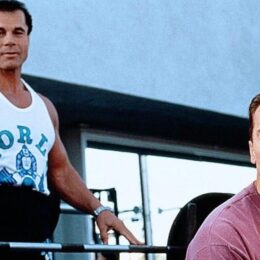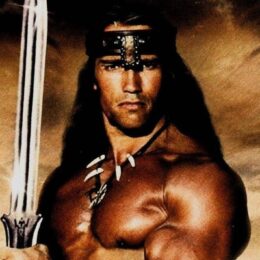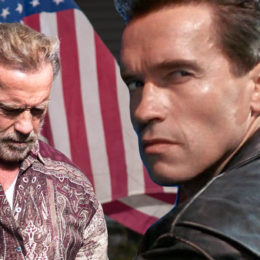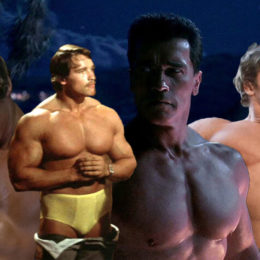From ELECTRONIC KILLER to INTERIOR DECORATOR. All Schwarzenegger’s TERMINATORS
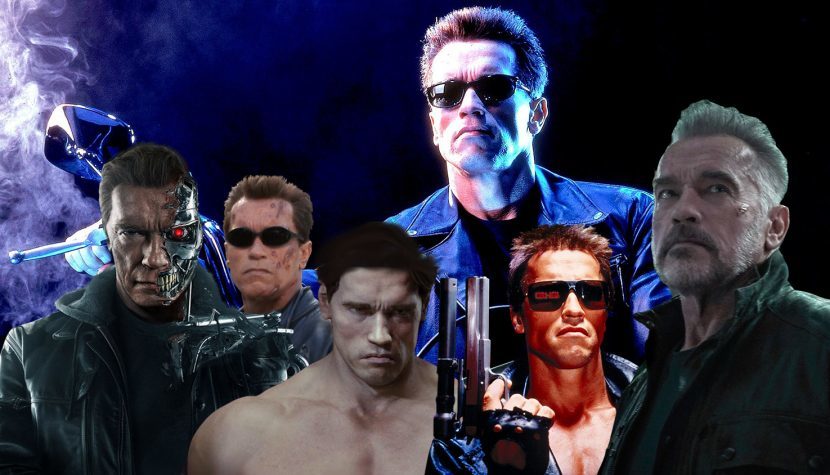
Arnold Schwarzenegger in 1984 erected for himself a Terminator statue more durable than made of bronze, although he actually has one made of bronze, too, and even sometimes sleeps under it. Arnold’s interpretation of the character of the sinister cyborg, or rather, his paradoxical lack of it, that is, in total, his mere presence in front of the camera, after all, the Austrian Oak, like an oak, spoke little and his facial expressions were non-existent, elevated the multiple Mr. Olimpia to the heights of film fame, where he remained for nearly three decades. Seemingly it was a one-off role, as the “electronic killer” (this is how the title was originally translated in poland) in the finale was stripped of Schwarzenegger’s face and then bowed to the pressure of the hydraulic press, winking at Sarah Connor with a red eye. So even for the sequel, a healthy combination was needed to bring the now iconic character back to life. In Judgment Day, which was made seven years later, everything still relatively held together, albeit the safest option was chosen; Skynet again sent an assassin, and the Resistance just as again a defender, and there was no need to hang disbelief on a peg to buy another, this time a good version of the T-800, after all, they were produced on tape, and could be programmed at will, as well as combed.

TERMINATOR CULT
And all in all, it was a good thing that the filmmakers for the last thirty found ways, silly more or less, to show the further fate of the Terminator laying eggs of gold for the producers. What matter that it was a different copy of the cyborg in each installment, the T-800, as a hero of the mass imagination of viewers around the world, was for the audience always the same, good (though not bad in the one) acquaintance, whom one wanted to watch on screen for as long as possible and once again. Significantly, when we look at all the Terminator parts as a whole, with the beginning in part one and the end in part six, it is easy to see that this three-decade-long extraordinary journey of the hero, resembles the fate of the tin woodcutter from The Wizard of Oz, who searched for his heart, remembering that he was happiest when he could love.

After all, no matter how you look at it, the Terminator started out in the guise of a young soulless assassin from the future, and ended up as a conscience-owning, conscience-removing, fancy-drinking keeper of the household, with his family by his side and his hair sprinkled with gray. A stretch? Like hell, but otherwise also naive. It’s a good thing, at least, that the cyborg trying to redeem himself didn’t start drinking, although there were rumored plans in the first Cameron installments of the franchise to require the T-800 to consume token amounts of food in order for his human skin to regenerate. There were even plans for a scene in which the Terminator would eat a candy bar, complete with wrapper. With the sixth installment of the franchise, Schwarzenegger said goodbye to the role of T-800 model 101 for good, and to audiences, after all, the financial flop of Dark Fate does not herald another sequel, and Arnold himself, after all, uttered a telling line in one of the scenes: I’m NOT coming back. And since literally moments ago Netflix announced the creation of an animation set in the Terminator universe, the handle on the Terminator cinematic franchise seems to have fallen for good.

However, I look back on these last Terminator rises of Schwarzenegger with a certain note of understanding, a sense of nostalgia and a sincere tear of emotion in my eye. For Arnold, so humanly speaking, deserved to be able to still savor and entertain himself with his iconic performance today, as a man who is, after all, justly old (he was carrying 72 springs on his neck on the set of Six). Outside of the movies, he did so, for example, in his famous pranks, where he walked the streets of L.A. in T-800 makeup, or pretended to be a wax figure of the T-800 and scared visitors with a sudden movement, and there was no end to the laughs and photos. We, on the other hand, as viewers, especially those raised on Terminators, should watch Schwarzenegger’s on-screen farewell with a big wink, trying to have a good time at the scenes in which the already aged Arnold quite skillfully throws enemy cyborgs across the screen. So aside from the embarrassing moments of recent installments (ah that sour romance between Jai Courtney and Emilia Clarke and Arnold’s shoddy matchmaking between them) and the warming of the T-800’s image to boiling point, I personally still enjoy watching Arnold. It’s cool that we can still see him on screen in action cinema, let’s enjoy it instead of vilely hating Dark Fate and Genisys! Ok, I’ve wiped away a tear of emotion, and now to the work, we go to trace the fate of our steel lumberjack. Well, and to cheer Dark Fate and Genisys.
Related:
TERMINATOR / 1984
It’s probably an unpopular opinion, but for me the first part of The Terminator will forever remain better than the sequel. Perhaps this is partly due to the fact that it was one of the first films I watched on VHS and my first screen encounter with Arnold Schwarzenegger, and this must have left an imprint on my memory and the area of the brain responsible for sentiment. In addition, I watched Cameron’s film with German dubbing at the time, which made it a good few years that I knew the iconic I’ll be back as… Ich komme wieder. Arnold’s T-800 model 101 (where T-800 meant the endoskeleton model and 101 meant the human image symbol) was extremely scary, soulless and perfectly emotionless. There was no human element in this villain, no flashes of white or even shades of gray, such as in Darth Vader, who spent half an hour wondering whether to save his son or his own reputation as a galactic sleuth. There were also no terminator heebie-jeebies or winks to the viewer, and the T-800 character was not the subject of any on-screen banter, unless we consider as such the choice of the response option Fuck you asshole among other, more cultured possibilities. In addition, the less the T-800 spoke, the more he seemed cold and inhuman, and since he was only given fourteen lines of text to speak, count yourself lucky.

The tinted, distinctive Gargoyles glasses (a year before the T-800 was paraded in them by Clint Eastwood in Sudden Impact), in this installment used by the cyborg to cover a blown-out eye, completed the on-screen look, adding to the T-800’s final dose of darkness and a solid dose of awesomeness. Wearing tinted glasses, by the way, became an attribute of our recalcitrant time-traveling machine in subsequent installments. Prior to shooting, Arnold Schwarzenegger reportedly spent long weeks learning how to assemble, disassemble, reload and fire every weapon used in the film – without looking at the guns. The result was a more robotic approach to gun handling, which added to the awesomeness and credibility of the Austrian’s creation. Recall the shootout in Tech-noir, when the T-800 standing over the lying Sarah Connor changes the magazine in the UZI, looking not at his hands or gun, but somewhere in the void. In order to make an indelible impression on audiences and write himself with golden voices in the history of cinema, Arnold only needed twenty-one minutes of screen time. And it’s hard to believe today that originally O.J. Simpson and Lance Henriksen (who reportedly came to the casting with gold foil on his teeth) among others, were tried on for the role of the Terminator Fortunately, Arnold, who came to the casting with muscles, won. Interestingly, initially the predator slayer was considered for the role of…. Kyle Reese, but at the casting in question he was considered the perfect villain.

Then there was the amazing theme song by Brad Fiedel and the unforgettable opening credits with letters flying across the screen forming the title. And then there are the action scenes, for me the best of all the Terminator parts. The electrifyingly dynamic shootout in the Technoir bar, and the darkly electrifying exchange of gunfire with the cops at the police station. All the awesomeness of the first Terminator, as it was to turn out, is not just some vague childhood memory of mine. Cameron’s classic watched this year, when I’m already 43, made a great impression on me, as if time had stopped for it, well, except maybe for the animatronics, which are a bit lame from today’s perspective. Coming back to Arnold Schwarzenegger, I think James Cameron came up with the jack time travel motif especially for him, so that he could show the muscular Austrian with a bare butt on the screen. The moment when a naked Arnold, filmed from behind, walks up to the railings looking out over nighttime Los Angeles remains for me, and I mean this quite seriously, one of the most amazing and iconic in the entire franchise. The whole idea of a cyborg from the future and the soldier pursuing him, supposedly dreamt up to Cameron in a nightmare, although the truth turned out to be closer to plagiarism than a dream nightmare.

Schwarzenegger, with only one big starring role – Conan the Barbarian – to his credit, was still a relatively unknown and still budding actor in 1984 (which, looking at the level of later acting, he probably remains to this day), did an excellent job in the role of a fearsome cyborg devoid of empathy and any feelings at all, who didn’t bow to bullets or anyone else. To deepen the distance and feeling of alienation between his cyborg and the couple he pursued, Arnold avoided Linda Hamilton and Michael Biehn on set. And damn, on screen it shows, until your skin suffers. The makeup, in the form of a burnt haircut and lack of eyebrows (supposedly these were insured in case they grew back badly after shaving), added an extra eeriness to his T-800 and completed the demonic image. Behind this image, and the amazing creation of the T-800’s endoskeleton, was the invaluable team of Stan Winston. To this day, the sequences of repairing the hand mechanism or the T-800’s own cutting out of the remnants of a human eye are still impressive. But Stan Winston’s team also went a little soft when it came to animating the endoskeleton in the final scenes. Did you know that the T-800 suffered a leg injury after being run over by a tanker truck, not coincidentally? It was a preparation for making it easier for the puppeteers and animators of the later sequence of the walking endoskeleton, which pulled the damaged leg… no longer needed to imitate Arnold’s gait. The computer instructions displayed on the Terminator’s HUD display were written in the MOS Technology 6502 assembly language, which was, among other things, the central processing unit of the Apple II personal computer. The T-800’s method of displaying messages survived unchanged for the 35 years of the entire franchise.

The film, with a running time of 107 minutes, the shortest of the series, was released in Poland in the late 1980s as Electronic Killer. This translation, often ridiculed, had its logical justification, however. In Poland at the time, the word “terminator” meant… apprentice. Indeed, I myself remember the word if only from Historia żółtej ciżemki, where Wawrzuś (a tiny Marek Kondrat) apprenticed with Wit Stwosz. So the title in our country, understandably, was changed to something more catchy, interesting and, above all, understandable to the public, because no one would want to watch a film about some apprentice. The situation was to be changed only by Terminator 2: Judgment Day, already appearing under its original title, so that in the early 1990s the word terminator was already widely recognized in our country as a character played by Arnold Schwarzenegger. The iconic line I’ll be back, uttered by Arnold Schwarzenegger in an inconspicuous scene at the police station, was chosen as the 37th best movie quote by the American Film Institute, and ranks 95th in The 100 Greatest Movie Lines. A close second, and the famous one-liner would have read I Will Be Back, which Schwarzenegger himself insisted on, motivating his suggestion by the fact that it sounds more mechanical. Fortunately, Cameron brought him back down to earth quickly by replying that I’ll be back sounds more cinematic.

The film with a budget of less than seven million dollars, shot almost guerrilla-style, and with cottage industry methods (Cameron used his knowledge gained on the sets of cheap Roger Corman films), earned nearly eighty million, was hailed as one of the best pictures of 1984, became a worldwide phenomenon, set Schwarzenegger’s career for the next two decades, and remains to this day Arnold’s own favorite film. And if someone had told me back then, when I was a kid with baked goods (and by no means baked goods) on my face after a screening of The Terminator, that someday this same badass, murdering without blinking an eye, would someday instruct… what curtains to choose for a child’s room, I would have put my hand to my forehead and said: Oy, it burns.
TERMINATOR 2: JUDGMENT DAY / 1991
It’s hard for me to believe this today, because I have tremendous respect for T2 and love to return to it, but when I first watched Judgment Day… it didn’t appeal to me much. I missed the character of Kyle Reese (I like Michael Biehn for the roles of Reese and Hicks from Aliens, what can I do?), but I missed even more the evil T-800, which in the sequel has already become such a bit of a cyborg-turned-hugger, if, of course, one likes to cuddle with cold steel. When it comes to overall momentum (the prologue is a masterpiece!) and special effects (T-1000 forever!), Judgment Day undoubtedly wins over the 1984 original. The film, by the way, earned as many as 6 Oscar nominations, 4 of which it turned into statuettes (best sound, sound effects, special effects, make-up), forever remaining the only film from the franchise with Oscar nominations. But the good T-800 gnawed at me, because I still had in my mind the relatively fresh image of the merciless, petulant Arnold from part one. Compared to part one, in part two, the T-800 has already talked, and in the following parts it’s a shame to talk. Except for Salvation, of course, because there he uttered even fewer words than in the first part, or, to be precise, not a single one. And although James Cameron in Judgment Day doesn’t make too much fun of the T-800, we can already see the first symptoms of humanizing the cyborg and turning towards a strong warming of the image of this extraordinary babysitter with nerves of steel and patience worthy of a machine.

Deprived of teaching, the cybernetic organism from the future begins to learn catchy phrases, where to find the keys in a stolen car, and, albeit unconsciously, how to be the perfect synonym for a father to John Connor. As Sarah puts it, one who will never hit John, never let him down, and never say he doesn’t have time for him. And while in the finale the T-800 admits that he already knows why people are crying, he states self-consciously that he won’t be able to do it himself, and sacrifices his existence for the safety of John, Sarah and all of humanity. Edward Furlong, who plays the teenage John Connor, got along with Arnold Schwarzenegger from the get-go, as the young actor grew up without a father, and Schwarzenegger was able to fill the role both in front of and off camera. The two actors understood each other so well because their film incarnations were emotionally of a similar age.

In the sequel, not only is Arnold already on the side of good, in addition, he swears in front of John Connor that he won’t kill anyone again, bludgeoning people in the legs from now on. The vow is so strong that its echoes can be heard all the way in Terminator: Genisys, where Sarah Connor mentions that Pops (that’s what the T-800 will be called) sometimes shoots people in the legs. In the director’s version of Cameron’s film, in addition to pouring on John’s almost paternal feelings and stopping the systemically uploaded urge to kill, the T-800 under his tutelage additionally learns to express joy, displaying a horse-like grin no longer appropriate for this character, even in its positive guise. Apparently, Arnold Schwarzenegger’s favorite moments from the entire series are those in which the Terminator tries to be human, because, according to Arnie, this is something fun, not just constant action and violence.

And while it wasn’t so glaring in Cameron’s film yet, the Avatar director has set a dangerous precedent in the Terminator universe that will have disastrous consequences in subsequent installments, starting a veritable avalanche of Arnold-Terminator jokes and twaddle. What else needs to be said about T2 is that Stan Winston’s team here did the best makeup in terms of T-800’s facial injuries, in the entire franchise. Unfortunately, the hairdressing department didn’t show off, having styled the T-800, who arrived from the future, with a hedgehog haircut right away, although in the 1984 film the cyborg only gained this hairstyle after a trial by fire. Neither T2 nor any of the subsequent films make any attempt to explain the sudden change in the hairstyle of the T-800, which were supposedly produced on tape, and thus by design, repetitively.

Interestingly, James Cameron asked Stan Winston to direct a teaser trailer, what today is called a teaser. Cameron didn’t want this teaser to be just early footage, so with a budget of $150,000 Winston created a teaser trailer that showed a futuristic assembly line producing copies of Terminator, all of which looked like Arnold Schwarzenegger. Cameron was pleased with this short, which he released to the world before the release of Judgment Day, fearing the public’s reaction to the final trailers showing Schwarzenegger’s return as the Terminator (after the Terminator in the first film was, after all, clearly destroyed). The Terminator production line in the film, we were not to see until 17 years later, in the finale of Terminator: Salvation.

Saving McG was not the first film to recreate the image of the 1984 T-800, as the filmmakers had already set themselves a similar task in Judgment Day. At that time, however, they didn’t resort to computer superimposition of the younger Arnold’s face on the double, etc., but James Cameron had a section of the corridor built, dressed Arnold Schwarzenegger in the original Terminator outfit and glasses, and that recreated a shot from the original film of the 1984 attack on the precinct, which was shown to Sarah Connor who was in a mental institution.

Taking into account Arnold Schwarzenegger’s fee of $15 million, and seven hundred words of dialogue, he was paid $21,429 per word. The famous Hasta la vista, baby thus cost, bagatelle, $85,716. Thanks to the release of the brilliantly received sequel, which, with a budget of $100 million, earned more than $500 worldwide, the Terminator became the only character listed on the American Film Institute’s list of the 100th heroes and villains, as a villain and a positive hero. An unused idea that was supposed to be in T2 was to send two Arnolds / T-800s into the past, one good and one bad, before it was decided that the T-1000 would ultimately be the villain. The two-Arnolds idea was finally used in Terminator: Genisys. It is also mentioned in Judgment Day that the wounds on the T-800’s body can heal, but again, it is not until Genisys that the idea will be developed, and there will be talk of complete tissue regeneration that takes years.
TERMINATOR 3: RISE OF THE MACHINES / 2003
And the jokes about the iconic cyborg, who shouldn’t be made fun of, began. I’ll tell you frankly that the famous star-shaped glasses, which the T-800 put on his face completely by accident, set up the whole movie for me the way a goal lost in the first minute sets up the team for the whole game, that is, moderately positively. I know that Terminator the glasses in question were immediately taken off and crushed under his shoe, but the aftertaste of profanity remained. Arnold Schwarzenegger returned to the role twelve years after the release of Judgment Day. It took that many years for the dust after the spectacular success of T2 to settle a bit, and for some director to dare to shoot a sequel, being doomed in advance to lose to Cameron’s masterpiece anyway. Schwarzenegger also had to contend with his own legend here, and while he did not fall in this clash sullenly, he did. And probably out of respect, or out of fear of Cameron’s reaction, he didn’t utter his one-liner business card in the Bridge film, namely I’ll be back. He replaced it conservatively with She’ll be back, and I’m back.

Arnold Schwarzenegger trained for three months, about three hours a day, before shooting began, when he found that he already had exactly the same body mass and muscles as he had 12 years earlier while filming Terminator 2. The 56-year-old actor was worried about his undressed scene (a hallmark of the series) because he knew viewers would compare it to those in previous installments. As is well known, Arnold performed perfectly without clothing. However, this was the last installment of the franchise in which we see Arnold in a nude version, as well as the last in which we see his arrival from the future at all. The film’s director, Jonathan Mostow, was unfortunately unable to wring as much out of Arnold as Cameron managed on the sets of T2 or True Lies, making the Austrian Oak’s acting in Rise of the Machines seem severely wooden. Schwarzenegger here, moreover, stands in a pop-culture limbo between being a still menacing cyborg, able to stand up to the newer Terminatrix (by which he loses his head, literally), and being a cool cyborg, throwing cool lyrics like a glove; Talk to the hand is unfortunately such Hasta La Vista for the poor. Arnold’s image is also not improved by a much weaker make-up than in T2, in the final part of the film largely digital and artificial-looking. And one question troubles me, how did the T-800 in Rise of the Machines, a cyborg after all, brand-new and unwashed, know where to look for the keys in a stolen car, since John Connor in Judgment Day showed this trick to another copy?

As for the development of our hero’s humanity, already in this part he seeks redemption in his own way for killing John Connor. He does it a bit unconsciously, because he is programmed to protect the young John (the T-800 killed / will kill the older version in the future), and he has no choice but to protect this victim of fate, because in this version John Connor is such. However, the T-800 this time, instead of the affectionate protector we remember from T2, becomes a stern tutor, who checks Connor’s injuries with a sternness, at times jerking the hapless man around like a sack of potatoes, or abusing him by strangling him when pressed against a wall. Schwarzenegger at the time of the filming of Rise of the Machines was 56 years old on the counter, meaning he was closer to sixty than to fifty (but I fudged the conclusion), and although he still looked ferocious on screen, even in the unclothed version, he was already wearing, instead of a T-shirt, a turtleneck partially covering his neck, which betrayed the first signs of such, and not other, age of Arnold. In a word, this was the last film in which Schwarzenegger still resembled the T-800 we knew; in future installments, the filmmakers will already have to reinforce the actor’s digital doubles, or push the audience with the bullshit (hello Genisys!) that the Terminators are aging and may be named Pops.

A close second, and from the Rise of the Machines we would have learned how the T-800 got such a face and not another. Well, its donor was supposed to be a certain military man, Sergeant Candy (Sergeant CANDY? What the hell?) played, of course, by Arnold Schwarzenegger. The military man, presenting the final work on the cyborg, smiles directly at the camera as broadly as he did in the director’s version of T2. It’s a pity that this scene didn’t make it into the film in the final version, because we would have known to whom we owed the T-800’s twisted teeth-drying. We would also have learned where the T-800’s voice came from, since Arnold in the scene in question doesn’t speak in his own voice, but one substituted by another actor. The voice, due to the accent, does not please the other military men. Then a government employee speaks up and… in Arnold’s voice he says Fix it. On the one hand, the whole deleted sequence as a separate thumbnail comes off pretty cool; on the other hand, it was too comforting on its own to be squeezed into a movie where we had to contend with star-crossed rose-colored glasses anyway.

The studios have long wanted to make a sequel to the Terminator films, but for a long time Arnold Schwarzenegger refused to participate in a potential sequel unless James Cameron was the director. This one, however, with his T2 said the last word on the subject and did not want to return to it. At the same time, major studios (including FOX) were apprehensive about making a big blockbuster starring Schwarzenegger, due to his now advanced age and the fact that he underwent heart valve replacement surgery in 1997. Cameron finally told his friend to just do it (star in the damn sequel) and that he would charge a mountain of money for it. The director argued his blessing on the fact that the T-800 character was as much Schwarzenegger’s as his own.
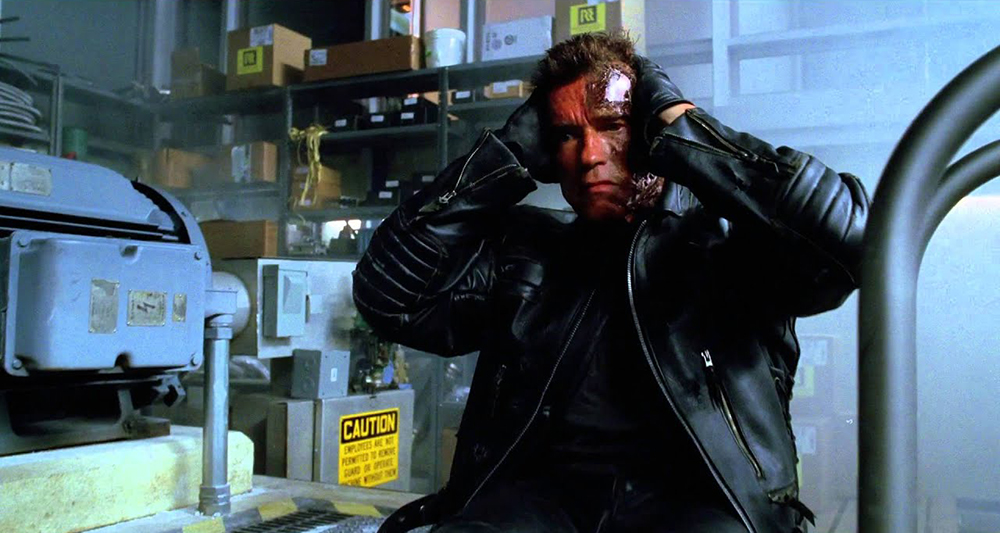
As expected, despite the presence of Arnold on board as the film’s driving force, the absence of the ship’s captain, i.e. James Cameron, meant that Rise of the Machines began the series’ box-office slide down an even keel. Jonathan Mostow’s film, with a budget of $140 million, 50 more than T2, may have earned a nice $430 million worldwide, but that was 70 million less in earnings than the Cameron sequel raked in at the theatrical box office. The biggest winner was Arnold, who negotiated close to $30 million for the role (even if the film had not been made at all), and stellar terms and privileges, such as $1.5 million for private jets, a fully equipped workout trailer, luxury three-bedroom apartments on site, 24-hour limousines, and personal security. It was the height of the actor’s popularity, a position to which he was never to return. Almost straight from the set of Terminator 3, he moved on to the California governor’s chair, which put his career on hold for ten years (ignoring episodic appearances).


